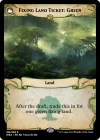So, I ordered up some playsets of proxy OG duals. Not counterfeits, but obvious proxies. I feel a bit annoyed about it, because I have the real cards for everything else.
The OG dual lands are just simpler than anything else. It's not too hard to process the similar but different drawbacks on Botannical Sanctum, Dreamroot Cascade, Hinterland Harbor, and Vineglimmer Snarl. But it's kind of a waste. A few copies of Tropical Island are so easy to figure out. It's a great cube solution apart from the fact that it currently costs something like $500 for a moderately played Revised copy or $220 for a 30th Anniversary proxy in 2015 frame. I am not interesting in moving up to that level of MTG spending.
If you think about it, the 30th Anniversary copies aren't even real proxies, because they're made by Hasbro. What a fail!
Related to that, has anybody considered running custom perfect triple lands instead of dual lands? That improves the chances that people get the lands they need in a draft pod, and it does it without all of the nuisance shuffling you get from fetch lands. You could even run quad lands, but then you're really pushing 5C decks.
I think my preferred solution right now would be to have some dual lands to draft in the cube, and after the draft you can trade up to X dual lands in for others in the box that match at least one of the colors. In that system, people can draft good manabases and cast their spells, it still matters which and how many dual lands you draft, you don't need any voucher cards, the system is relatively simple, and you're not favoring 4-5 color decks since the lands only produce two colors at the end of the day. Also no shuffling for lands.
A system like that works better if you can have a stack of dual lands of one type, and the ones I'd want are the OG's. There's always the option of Tangled Islet and a Sharpie, of course. Maybe upgrade that to more of a pseudo altered card by covering up "enters tapped" with paint instead of sharpie.
The OG dual lands are just simpler than anything else. It's not too hard to process the similar but different drawbacks on Botannical Sanctum, Dreamroot Cascade, Hinterland Harbor, and Vineglimmer Snarl. But it's kind of a waste. A few copies of Tropical Island are so easy to figure out. It's a great cube solution apart from the fact that it currently costs something like $500 for a moderately played Revised copy or $220 for a 30th Anniversary proxy in 2015 frame. I am not interesting in moving up to that level of MTG spending.
If you think about it, the 30th Anniversary copies aren't even real proxies, because they're made by Hasbro. What a fail!
Related to that, has anybody considered running custom perfect triple lands instead of dual lands? That improves the chances that people get the lands they need in a draft pod, and it does it without all of the nuisance shuffling you get from fetch lands. You could even run quad lands, but then you're really pushing 5C decks.
I think my preferred solution right now would be to have some dual lands to draft in the cube, and after the draft you can trade up to X dual lands in for others in the box that match at least one of the colors. In that system, people can draft good manabases and cast their spells, it still matters which and how many dual lands you draft, you don't need any voucher cards, the system is relatively simple, and you're not favoring 4-5 color decks since the lands only produce two colors at the end of the day. Also no shuffling for lands.
A system like that works better if you can have a stack of dual lands of one type, and the ones I'd want are the OG's. There's always the option of Tangled Islet and a Sharpie, of course. Maybe upgrade that to more of a pseudo altered card by covering up "enters tapped" with paint instead of sharpie.



